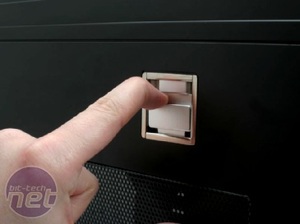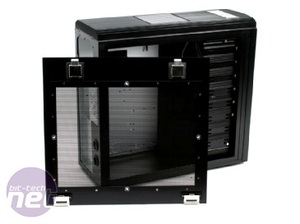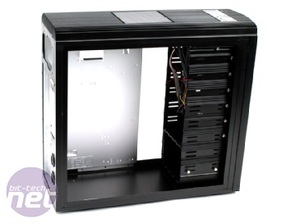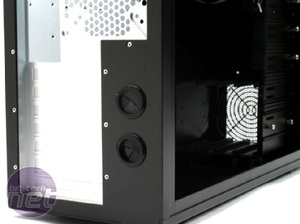
Open The Sarcophagus!
Now, this is where the Anubis gets really good. Before it was just an oddly attractive case, but when you take off the side panels then you start to see some of the holiness which makes this case worthy of a God’s name.It’s all in the latches.
As I mentioned before, the side panels of the Anubis aren’t secured on in a normal manner. There’s no thumbscrews to fiddle with around the back, instead the side panels can just be taken off by pulling down on the latches on the side.
These latches aren’t going to interest everyone admittedly and if you’re looking for a good case to start modding with then you’ll prefer something with smooth, flat, naked side panels. If however you’re more of a system-fiddler than a case-changer then you’ll be very interested in the latches as it means you’ll be able to get in and out of the case without delay.
And trust me, the small amount of time it takes to take off some thumbscrews can make all the difference in the world when you’re stealing a graphics card from Tim. Hypothetically, of course.
The design of the side panels is made even better by the use of spring-loaded catches on the bottom which hold the panel onto the frame securely. It’s a lot better than the usual little line of hooks and holes which have to be lined up and slid in – after the hundredth time that system becomes a real pain.
Moving onto the inside of the case brings the usual oohs and aahs, good things and bad. For example, it’s a good thing that the inside of the case has also been finished in the high quality black paint, but it’s a bad thing that the motherboard tray isn’t removable. The main problem with the inside of the case though is the lack of fans. There’s space for three fans in the case if you look at it as-is and don’t start cutting extra holes in it. You can put one in the top, back and front.
Unfortunately, the Anubis only comes with a single 120mm fan in the top of the case. That makes it one of the few cases I’ve seen that doesn't feature a fan in the back of the case, which is usually the default position.
The Anubis has a series of smaller but worthwhile features inside, like engraved labelling of all the stand-off holes so that motherboards can be mounted easily. The HDD cage is also removable through the front of the case, which is great if you’ve shoved the motherboard and GPU in before the HDD and don’t want to have to remove everything to get access.
The left hand side panel is a little odd in that it has both a metal grille and a plastic window, with the former on top and neither easily removable.
Actually, that last sentence isn’t strictly true. The window and grille are easily removed as they can be unscrewed if the side panel is taken off. However, the inside of the case is dotted with stickers labelled “Warranty void if removed”, which makes the choice of whether or not to remove the screws the hard part really.
When you think about it though, the window and grille method gives you the best of both worlds – the window deadens the sound more than the grille, but the grille looks better and fits with the overall aesthetic. It also helps to keep the components inside the case completely shielded from the outside world.
Even the stickers are a plus point when you think about it and, to borrow Rich’s wording, they are essentially a message to the owner saying that, sure, you can take it apart and mod it – but we won’t fix it if you do. Better to have these stickers and know where you stand than to need help and spend ages looking in the wrong places.
Still, whether or not all these little tweaks actually make system installation and performance any better remains to be seen...

MSI MPG Velox 100R Chassis Review
October 14 2021 | 15:04












Want to comment? Please log in.